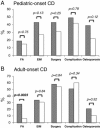Identifying the Neurogenetic Framework of Crohn's Disease Through Investigative Analysis of the Nucleotide-binding Oligomerization Domain-containing Protein 2 Gene Mutation
- PMID: 31723489
- PMCID: PMC6825438
- DOI: 10.7759/cureus.5680
Identifying the Neurogenetic Framework of Crohn's Disease Through Investigative Analysis of the Nucleotide-binding Oligomerization Domain-containing Protein 2 Gene Mutation
Abstract
Among several inflammatory bowel diseases, Crohn's disease is associated with inflammation that may take place in any region of the gastrointestinal tract. The inflammatory process is most commonly associated with the ileum, often spreading deep into the bowel tissues, extending into multiple forms, such as strictures and penetrations. Currently, Crohn's disease has no known cure. Various medical and surgical procedures are used to manage the condition. The underlying mechanisms of the disease are yet to be identified, with recent studies suggesting the influence of genetics, environmental factors, and the possible activity of pathogens. Newer studies also offer strong evidence that suggests a relationship between Crohn's disease and the nucleotide-binding oligomerization domain-containing protein 2 (NOD2) gene, also known as inflammatory bowel disease protein 1 (IBD1) or caspase recruitment domain-containing protein 15 (CARD15). NOD2 is responsible for the mechanism in which the immune system identifies foreign microorganisms through the sensing of pathogen-associated molecular patterns in microorganisms. NOD2 can detect intracellular muramyl dipeptide (MDP) in the bacterial wall, thereby causing an inflammatory response. Three major mutations associated with the NOD2 gene are known to have an influence on Crohn's disease (SNP8, SNP12, and SNP13). This article will discuss a number of studies to identify whether there is a relationship between Crohn's disease and the NOD2 gene.
Keywords: card15; crohn’s disease; inflammatory bowel diseases; nod2.
Copyright © 2019, Sakibuzzaman et al.
Conflict of interest statement
The authors have declared that no competing interests exist.
Figures

Similar articles
-
NOD2/CARD15 mutations in Croatian patients with Crohn's disease: prevalence and genotype-phenotype relationship.Eur J Gastroenterol Hepatol. 2006 Aug;18(8):895-9. doi: 10.1097/00042737-200608000-00016. Eur J Gastroenterol Hepatol. 2006. PMID: 16825909
-
CARD15 single nucleotide polymorphisms 8, 12 and 13 are not increased in ethnic Danes with sarcoidosis.Respiration. 2007;74(1):76-9. doi: 10.1159/000090638. Epub 2006 Jan 2. Respiration. 2007. PMID: 16397396
-
NOD1 gene E266K polymorphism is associated with disease susceptibility but not with disease phenotype or NOD2/CARD15 in Hungarian patients with Crohn's disease.Dig Liver Dis. 2007 Dec;39(12):1064-70. doi: 10.1016/j.dld.2007.09.003. Epub 2007 Oct 26. Dig Liver Dis. 2007. PMID: 17964870
-
Crohn's disease: a role of gut microbiota and Nod2 gene polymorphisms in disease pathogenesis.Acta Medica (Hradec Kralove). 2014;57(3):89-96. doi: 10.14712/18059694.2014.46. Acta Medica (Hradec Kralove). 2014. PMID: 25649363 Review.
-
Nucleotide-binding oligomerization domain containing 2: structure, function, and diseases.Semin Arthritis Rheum. 2013 Aug;43(1):125-30. doi: 10.1016/j.semarthrit.2012.12.005. Epub 2013 Jan 24. Semin Arthritis Rheum. 2013. PMID: 23352252 Review.
Cited by
-
Identification of Potential Genes and Critical Pathways in Postoperative Recurrence of Crohn's Disease by Machine Learning And WGCNA Network Analysis.Curr Genomics. 2023 Oct 27;24(2):84-99. doi: 10.2174/1389202924666230601122334. Curr Genomics. 2023. PMID: 37994325 Free PMC article.
-
NOD2 is involved in regulating odontogenic differentiation of DPSCs suppressed by MDP through NF-κB/p65 signaling.Cytotechnology. 2022 Apr;74(2):259-270. doi: 10.1007/s10616-022-00526-2. Epub 2022 Feb 8. Cytotechnology. 2022. PMID: 35464161 Free PMC article.
-
Muramyl dipeptide-based analogs as potential anticancer compounds: Strategies to improve selectivity, biocompatibility, and efficiency.Front Oncol. 2022 Sep 27;12:970967. doi: 10.3389/fonc.2022.970967. eCollection 2022. Front Oncol. 2022. PMID: 36237313 Free PMC article. Review.
References
-
- Regional ileitis: a pathologic and clinical entity. Crohn BB, Ginzburg L, Oppenheimer GD. JAMA. 1932;99:1323–1329. - PubMed
-
- Crohn's disease in Olmsted County, Minnesota, 1940-1993: incidence, prevalence, and survival. Loftus EV Jr, Silverstein MD, Sandborn WJ, Tremaine WJ, Harmsen WS, Zinsmeister AR. Gastroenterology. 1998;114:1161–1168. - PubMed
-
- Prevalence of inflammatory bowel disease among adults aged ≥ 18 years—United States, 2015. Dahlhamer JM, Zammitti EP, Ward BW, Wheaton AG, Croft JB. MMWR Morb Mortal Wkly Rep. 2016;65:1166–1169. - PubMed
-
- Increasing incidence and prevalence of the inflammatory bowel diseases with time, based on systematic review. Molodecky NA, Soon IS, Rabi DM, et al. Gastroenterology. 2012;142:46–54. - PubMed
Publication types
LinkOut - more resources
Full Text Sources
Research Materials
